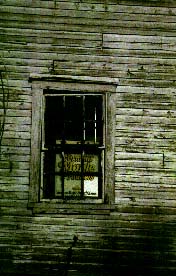TAKING
CARE OF YOUR OLD BARN
Tip # 8 - Keep Doors and Windows Repaired.
 As
the moving parts of your barn, windows and doors may require more maintenance
than other features, but their repair will be much less expensive than
buying replacements. Fixing windows and doors makes a good "rainy
day" project, when you have time to disassemble and adjust the parts
that keep these features working.
As
the moving parts of your barn, windows and doors may require more maintenance
than other features, but their repair will be much less expensive than
buying replacements. Fixing windows and doors makes a good "rainy
day" project, when you have time to disassemble and adjust the parts
that keep these features working.
Before the mid-nineteenth century
most barns had at least one pair of large wagon doors on long strap hinges,
as well as smaller hayloft doors and doors for people. After 1850 farmers
began installing sliding doors supported by wheels on a track. Over time,
more and more windows were added for light and ventilation, making chores
easier and animals healthier. Often each horse stall had its own window,
cow stables a row of small windows, and chicken coops large windows on
their south walls.
Doors are often damaged
by heavy use. First check hinges, latches, and sliding tracks to see
if they need to be adjusted or reset with longer or new screws. Damaged
boards along outside or bottom edges of doors can be patched or replaced
using new boards (that match the existing if possible). In buildings that
have settled or sagged due to structural problems doors often rub or jam
at the bottom or jump off their tracks. Repairing structural problems and
jacking up the building may solve door problems. Moving the sliding track
or trimming the door itself are last resorts if other methods have failed.
Windows may have broken
glass, deteriorated glazing, or problems with the wooden sash and frame.
Replacing or patching decayed, broken or missing pieces of the sash and
frame may require taking apart the window. Fortunately most windows are
made for this. New or recycled glass may be installed with new glazing
putty. (Remember to apply boiled linseed oil as a preservative to the wood
before glazing.) When painting windows, try to draw a line of trim enamel
along the edges of the panes overlapping 1/16 of an inch onto the glass
to seal out water. When scraping away excess paint, leave this amount of
overlap rather than scraping into the glazing putty. When needed, replacement
"barn sash" that matches the original can be ordered from lumberyard
catalogs or local woodworkers.
New window and door openings
dramatically change the historic appearance of a barn and should be
added only if needed. New windows and doors should be of a size, proportion,
and type similar to existing windows and doors. They should be placed and
spaced so that they fit in with the existing pattern of door and window
openings and do not call attention to themselves.
© 1995 Vermont Division for Historic Preservation
and Vermont Housing and Conservation Board. All rights reserved.
Forward to Barn Tip #9...
Back to the Table of Contents...
 As
the moving parts of your barn, windows and doors may require more maintenance
than other features, but their repair will be much less expensive than
buying replacements. Fixing windows and doors makes a good "rainy
day" project, when you have time to disassemble and adjust the parts
that keep these features working.
As
the moving parts of your barn, windows and doors may require more maintenance
than other features, but their repair will be much less expensive than
buying replacements. Fixing windows and doors makes a good "rainy
day" project, when you have time to disassemble and adjust the parts
that keep these features working.